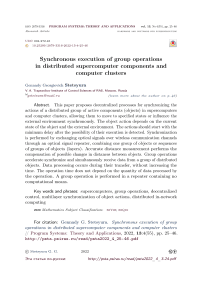Synchronous execution of group operations in distributed supercomputer components and computer clusters
Автор: Stetsyura Gennady Georgievich
Журнал: Программные системы: теория и приложения @programmnye-sistemy
Рубрика: Программное и аппаратное обеспечение для супер ЭВМ
Статья в выпуске: 4 (55) т.13, 2022 года.
Бесплатный доступ
This paper proposes decentralized processes for synchronizing the actions of a distributed group of active components (objects) in supercomputers and computer clusters, allowing them to move to specified states or influence the external environment synchronously. The object action depends on the current state of the object and the external environment. The actions should start with the minimum delay after the possibility of their execution is detected. Synchronization is performed by exchanging optical signals over wireless communication channels through an optical signal repeater, combining one group of objects or sequences of groups of objects (layers). Accurate distance measurement performs the compensation of possible changes in distances between objects. Group operations accelerate synchronize and simultaneously receive data from a group of distributed objects. Data processing occurs during their transfer, without increasing the time. The operation time does not depend on the quantity of data processed by the operation. A group operation is performed in a repeater containing no computational means.
Supercomputers, group operations, decentralized control, multilayer synchronization of object actions, distributed in-network computing
Короткий адрес: https://sciup.org/143179416
IDR: 143179416 | DOI: 10.25209/2079-3316-2022-13-4-25-46
Список литературы Synchronous execution of group operations in distributed supercomputer components and computer clusters
- D. Tennenhouse, J. M. Smith, W.D. Sincoskie, D. J. Wetherall, G. J.Minden. “Asurvey of active network research”, IEEECommunications Magazine, 35:1 (1997), pp. 80–86. https://doi.org/10.1109/35.568214 ↑28
- N. Zilberman, P. M. Watts, C. Rotsos, A. W. Moore. “Reconfigurable network systems and software defined networking”, Proc. of the IEEE, 103:7 (2015), pp. 1102–1124. https://doi.org/10.1109/JPROC.2015.2435732 ↑28
- Y. Tokusashi, Tu Dang H., F. Pedone, R. Soulé, N. Zilberman. “The case for in-network computing on demand”, EuroSys ’19: Proceedings of the Fourteenth EuroSys Conference 2019 (March 25–28, 2019, Dresden, Germany), ACM, New York, 2019, ISBN 978-1-4503-6281-8, 16 pp. https://doi.org/10.1145/3302424.3303979 ↑39
- A. Sapio, I. Abdelaziz, A. Aldilaijan, M. Canini, P. Kalnis. “In-network computation is a dumb idea whose time has come”, HotNets-XVI: Proceedings of the 16th ACMWorkshop on Hot Topics in Networks (30 November–1 December, 2017, Palo Alto, CA, USA), ACM, New York, 2017, ISBN 978-1-4503-5569-8, pp. 150–156. https://doi.org/10.1145/3152434.3152461 ↑
- D. Kim. Towards elastic and resilient in-network computing, CMUCS-21-143, Carnegie Mellon University, Pittsburgh, 2021, 150 pp. hUtRtpL://reports-archive.adm.cs.cmu.edu/anon/2021/CMU-CS-21-143.pdf
- IEEE standard for a precision clock synchronization protocol for networked measurement and control systems, IEEE Std 1588-2008 (Revision of IEEE Std 1588-2002), 2008, 269 pp. https://doi.org/10.1109/IEEESTD.2008.4579760 ↑28, 35
- IEEE standard for a precision clock synchronization protocol for networked measurement and control systems, IEEE 1588-2019, IEEE Instrumentation and Measurement Society, 2020. hUtRtpLs://standards.ieee.org/ieee/1588/6825/
- F. Girela-López, J. López-Jiménez, M. Jiménez-López, R. Rodríguez, E. Ros, J. Díaz. “IEEE 1588 high accuracy default profile: Applications and challenges”, IEEE Access, 8 (2020), pp. 45211–45220. https://doi.org/10.1109/ACCESS.2020.2978337 ↑28, 34, 35
- Sliwczynski Ł., P. Krehlik, Buczek Ł., Schnatz H.. “Picoseconds-accurate fiber-optic time transfer with relative stabilization of lasers wavelengths”, Journal of Lightwave Technology, 38:18 (2020), pp. 5056–5063. https://doi.org/10.1109/JLT.2020.2999158
- P. Moreira, I. Darwazeh. Digital femtosecond time difference circuit for CERN’s timing system, 4 pp. hUtRtpLs://www.ee.ucl.ac.uk/lcs/previous/LCS2011/LCS1136.pdf ↑28, 33, 34, 35
- G. Stetsyura. “Addition for supercomputer functionality”, RuSCDays 2016: Supercomputing, Communications in Computer and Information Science, vol. 687, eds. Voevodin V., Sobolev S., Springer, Cham, 2017, ISBN 978-3-319-55668-0, pp. 251–263. https://doi.org/10.1007/978-3-319-55669-7_20
- W. S. Rabinovich, P. G. Goetz, R. Mahon, L. A. Swingen, J. L. Murphy, M. Ferraro, H. R. Burris, Ch. I. Moore, M. R. Suite, G. Ch. Gilbreath, S. C. Binari, D. J. Klotzkin. “45-Mbit/s cat’s-eye modulating retroreflectors”, Optical Engineering, 46:10 (2007), 104001, 8 pp. https://doi.org/10.1117/1.2789634
- Y. Zhu, G.Wang. “Research on retro-reflecting modulation in space optical communication system”, IOP Conference Series Earth and Environmental Science, vol. 108, 2018.
- G. G. Stecyura. “Network information-computing support of automatic mobile objects interaction”, Problemy‘ upravleniya, 2018, no. 5, pp. 56–65 (in Russian). hMttNp://mi.mathnet.ru/pu1h1t0tp2s://doi.org/10.25728/pu.2018.5.6 ↑32
- Stecyura G. G.. “Decentralized autonomic synchronization of interaction processes of mobile objects”, Problemy‘ upravleniya, 2020, no. 6, pp. 47–56 (in Russian). https://doi.org/10.25728/pu.2020.6.5 ↑
- G. G. Stetsura. “Comments on “Peripheral interface standards for microprocessors””, Proceedings of the IEEE, 65:11 (1977), pp. 1920. https://doi.org/10.1109/PROC.1977.10790
- M. Bosiljevac, D. Babić, Z. Sipus. “Temperature-stable LED-based light source without temperature control”, Photonic Instrumentation Engineering III (15 March 2016, San Francisco, CA, USA), Proc. SPIE, vol. 9754, 2016, 6 pp. https://doi.org/10.1117/12.2211576


